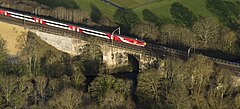Tees Bridge, Croft-on-Tees
| Tees Bridge | |
| County Durham, Yorkshire | |
|---|---|

| |
| Location | |
| Carrying: | East Coast Main Line |
| Crossing: | River Tees |
| Location | |
| Grid reference: | NZ290092 |
| Location: | 54°28’39"N, 1°33’9"W |
| Structure | |
| Length: | 471 feet |
| History | |
| Built 1837 - 1841 | |
| Information | |
| Owned by: | Network Rail |
The Tees Bridge or Croft Viaduct is a railway bridge carrying the East Coast Main Line between Northallerton and Darlington across the River Tees, the border between the North Riding of Yorkshire and County Durham.
This was an early example of a stone viaduct in the railway system, though not quite the first true railway viaduct. It was however the first railway viaduct in the United Kingdom to have been built with an oblique arch (or skew-arch). It had overhead line equipment installed in the early 1990s.
The viaduct is a Grade II listed building.[1]
History
The viaduct was designed by Henry Welsh, and built by Deas and Hogg for the Great North of England Railway (GNER) between 1837 and 1840, costing £14,481.[2][3] Digging for the foundations started on 25 November 1837, and the formation of the line northwards from the viaduct would go on to use the trackbed of the old Croft branch of the Stockton & Darlington Railway.[4] The trackbed was later purchased by the Great North of England Railway.[5]
The viaduct is 471 feet long (7 chains) according to Trackmaps[6]), 49 feet above the water of the River Tees, and each of the four arches is 45 feet across, or 59 feet if the 49-degree skew of the arches is taken into consideration).[7][8] The height of the viaduct from the normal water level to the top of the stone parapets is 58 feet and the width of the bridge is 27 feet.[9]
The Tees Bridge crosses the River Tees about half a mile east of Croft Bridge (which carries the A167 road), and curves slightly to the south east.[10] The viaduct is the most significant engineering structure built on the section of line between York and Darlington, and was opened to traffic in 1841.[11]
The original Croft Branch of the Stockton & Darlington Railway had a proposal to cross the Tees to venture one mile into Yorkshire, but the cost of building a bridge was found to have been prohibitive.[12] The Croft Branch was also further north (upstream) of the position of Croft Viaduct.
During construction, the building of the viaduct was beset by labour disputes, with the engineer being authorised to hire more men to complete the building phase at the contractors' expense.[13] It is one of the oldest viaducts on the railway network, and was the first railway viaduct in the United Kingdom to be built with a skew-arch.[14][15] Apart from some re-enforced concrete, the viaduct is largely composed of the original stone; dressed ashlar cream sandstone, with late 20th century parapet railings.[16][1]
There is a tradition that a newly appointed bishop arriving into County Durham be presented with a falchion which slayed the Sockburn Worm at Croft Bridge just upstream. However, in 1860, Henry Montagu Villiers arrived by train, and so the locomotive was stopped on Croft Viaduct to allow the ceremony to take place.[17][18]
References
- ↑ 1.0 1.1 National Heritage List 1131366: Tees Bridge (Grade II listing)
- ↑ Simmons, Jack; Biddle, Gordon (2003). The Oxford companion to British railway history from 1603 to the 1990s. Oxford: Oxford University Press. pp. 47, 192. ISBN 0-1986-6238-6.
- ↑ Hoole, Kenneth (1986). The North East (3 ed.). Newton Abbot: David & Charles. p. 94. ISBN 0-9465-3731-3.
- ↑ "Disused Stations: Croft Station". http://disused-stations.org.uk/c/croft_spa/index0.shtml.
- ↑ Hardie 2019, p. 14.
- ↑ Kelman, Leanne (2020). Railway Track Diagrams Book 2: Eastern. Frome: Trackmaps. 20. ISBN 978-1-9996271-3-3.
- ↑ Rennison & Barbey 1996, p. 136.
- ↑ "Genuki: Croft On Tees Parish information from Bulmers' 1890., Yorkshire (North Riding)". https://www.genuki.org.uk/big/eng/YKS/NRY/CroftOnTees/CroftOnTees90.
- ↑ Tomlinson, William Weaver (1967). Tomlinson's North Eastern Railway : Its rise and development. Newton Abbot: David & Charles. p. 359. OCLC 872328861.
- ↑ Tomlinson, William Weaver (1967). Tomlinson's North Eastern Railway : Its rise and development. Newton Abbot: David & Charles. p. 295. OCLC 872328861.
- ↑ Rennison & Barbey 1996, p. 135.
- ↑ Hardie 2019, pp. 8–9.
- ↑ Hoole, Kenneth (1986). The North East (3 ed.). Newton Abbot: David & Charles. pp. 94–95. ISBN 0-9465-3731-3.
- ↑ Betteney, Alan (2019). "Crossing the Tees". Cleveland Industrial Archaeology Society & Tees Archaeology. p. 15. https://teesarchaeology.com/wp-content/uploads/2023/04/Crossing-the-Tees.pdf.
- ↑ Maciver, P. S. (1885). The growth of the railway system : a lecture. London: Railway Review. p. 8. OCLC 1051487361.
- ↑ Biddle, Gordon (2003). Britain's historic railway buildings: an Oxford gazetteer of structures and sites. Oxford: Oxford University Press. p. 409. ISBN 0198662475.
- ↑ "Croft Railway Bridge". https://www.bridgesonthetyne.co.uk/croftrl.html.
- ↑ Lloyd, Chris (16 December 2009). "Mr Cheese spreads the word, but gets into a bit of a pickle". The Northern Echo. https://www.thenorthernecho.co.uk/history/4798018.mr-cheese-spreads-word-gets-bit-pickle/.
- Croft Railway Bridge: Bridges on the Tyne
- Rennison, Robert William; Barbey, M. F. (1996). Civil engineering heritage. Northern England (2 ed.). London: T. Telford. ISBN 0-7277-2518-1.
- Hardie, Caroline: 'The Croft Branch Line of the Stockton & Darlington Railway' (Archaeo-Environment Ltd, June 2019)
| Bridges and crossings on the River Tees | ||||||
|---|---|---|---|---|---|---|
| A1(M) Bridge | Blackwell Bridge | Croft Bridge | Tees Bridge | Low Hail Bridge | Neasham Hall Bridge | Girsby Bridge |